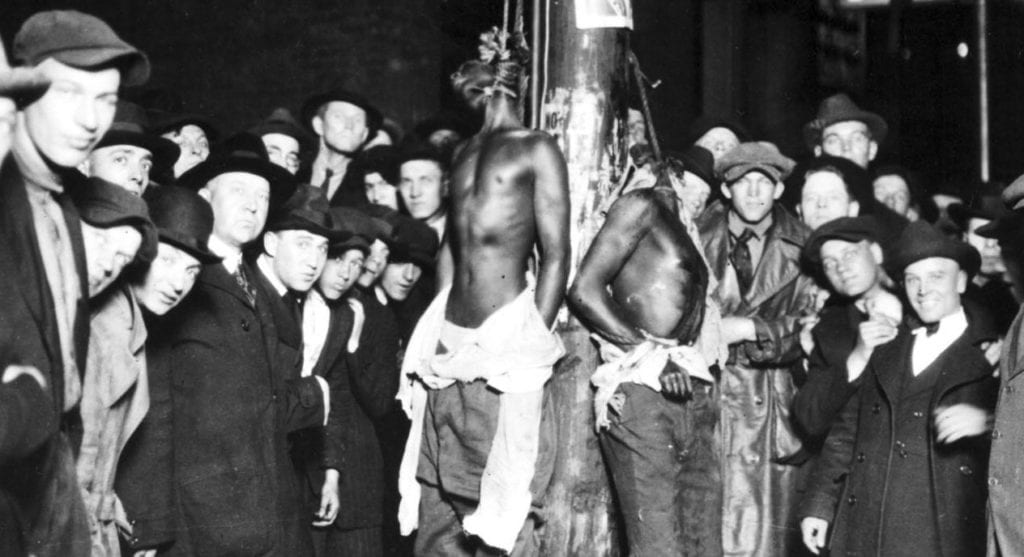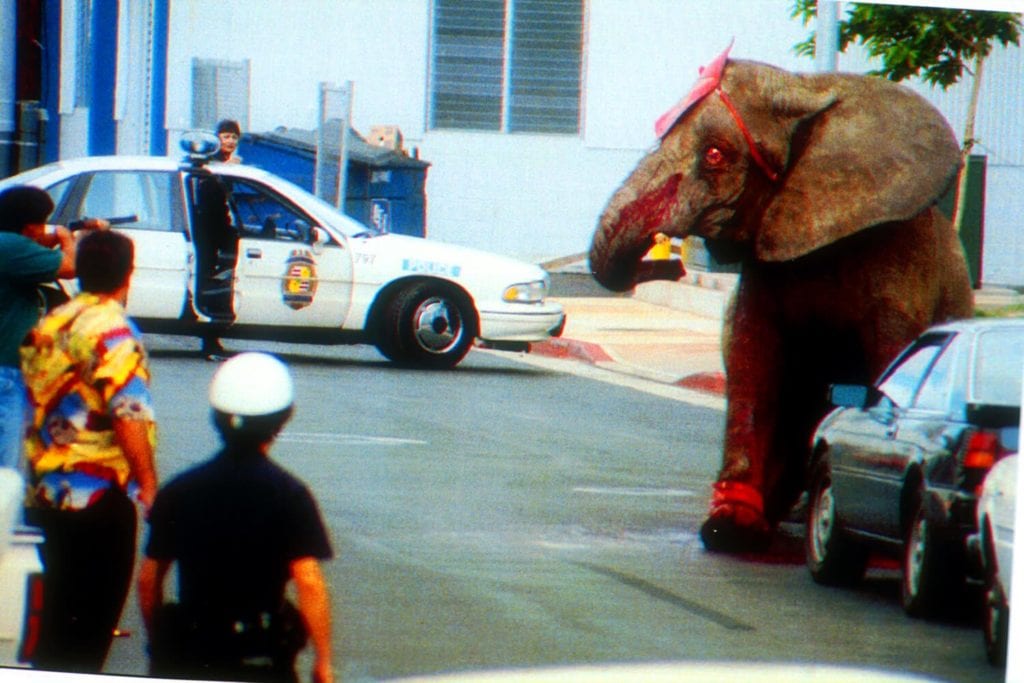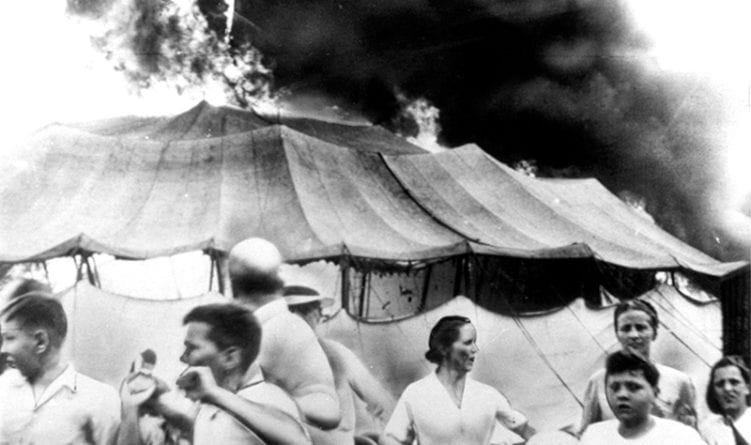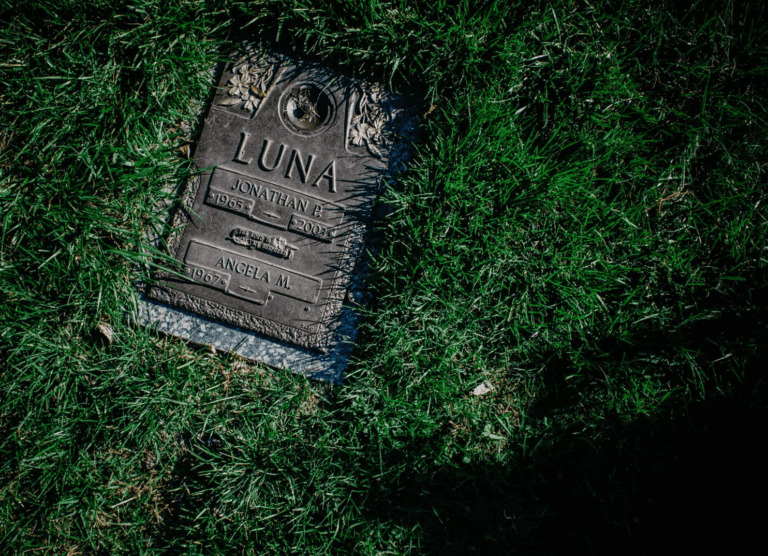Generations of children have joyfully anticipated the day the circus rolls into their hometown. From death-defying acrobatics to animated clowns and popcorn, it’s easy to see why the circus appeals to many children. However, circus life can be perilous; whether malfunctioning high wires, animal tragedies, or fires, when something goes wrong, it can be life-threatening. Here, we count down five of the most horrific circus tragedies in history.
The Duluth Lynchings

In the early 20th century, lynchings in America were rampant. While many took place in the Deep South, the 1920 lynching of three African American circus performers took place in the large Minnesota city of Duluth. In fact, it was the only time in American history that African Americans were lynched in Minnesota. And wasn’t the work of a small band of vigilantes, either, but instead a group of thousands, most of which were men still dressed in their work suits.
On the 14th of June, 1920, Irene Trusken, 19, and Jimmie Sullivan, 18, attended the John Robinson Circus which had just rolled into town for a one night performance in Duluth, Minnesota. Afterwards, the couple claimed that six African American circus workers robbed them at gunpoint and then raped Trusken. Despite the fact that no evidence corroborated their claims – including an examination by a doctor – local police rushed to the John Robinson Circus and hauled the six so-called attacker to the jail on Superior Street.1 Following the arrests, newspapers were quick to report on the alleged rape and rumours swiftly circulated around the town.
Later on that night, a mob of between 1,000 and 10,000 white men congregated in front of the jail; hours earlier, Louis Dondino drove through the town yelling for people to go to “the necktie party.”2 Upon arrival, the group stormed their way into the jail after police offices were ordered not to use the weapons on the crowd. Inside, the men proceeded to beat the six circus workers and held a kangaroo court. Then, they dragged three of the men – Elias Clayon, Elmer Jackson and Isaac McGhie – to the corner of Second Avenue East and First Street. One by one, each man was beaten again and then subsequently lynched from a lamppost. A photographer captured the scene and would later be sold as mementos in the form of grim postcards.
The lynching made headlines throughout the country and left a stain on Duluth. A grand jury had difficulty identifying the mob leaders and ultimately, just 37 indictments were made for the lynch; 25 for rioting and 12 for first degree murder. However, nobody was ever prosecuted for the three murders. Despite any evidence, ten other African American circus workers were indicted for rape. The NAACP hired defence lawyers for the ten men and five had their charges dismissed. Max Mason and William Miller were tried for the rape; Miller was acquitted while Mason was sentenced to seven to thirty years behind bars. He served four years before being released on condition he never leave the state.
Tyke the Elephant

Tyke was a 20-year-old African bush elephant who was captured in Mozambique as a baby and shipped to America to perform in circuses. In 1993, she escaped from a circus performance in Altoona, Pennsylvania, and caused $14,000 damage. Just months later, she broke free and ran amok in the North Dakota State Fair. While nobody – including Tyke – was harmed, things would take a much uglier turn the following year in Honolulu, Hawaii.
On the 20th of August, 1994, during a performance at Circus International which was held at the Neal Blaisdell Center in Honolulu, Hawaii, Tyke burst into the area and kicked her groomer, Dallas Beckwith. Her trainer, Allen Campbell, rushed to intervene. Tyke threw him to the ground and stepped on his head, killing him instantly. Afterwards, she ran out of the arena and on to the busy streets of Honolulu’s commercial district. After chasing Tyke through the city, police cornered the terrified animal and shot her 86 times until she fell to the ground. The photo capturing the moment depicts the evident terror and pain in Tyke’s eyes. As she lay on the ground, shaking with fear and covered in blood, local zoo officials gave her a lethal injection. When the lethal dose didn’t kill her, she was shot once again through the heart. Following her death, Tyke was loaded onto a flatbed truck and disposed of in Waimanalo Gulch Landfill in Nanakull.
Tyke became a symbol for animal rights and her death brought to the fore a debate about whether or not wild animals should be used for entertainment. Some tried to vilify her as a bad seed with a history of misbehaviour while others said she had suffered horrendous abuse at the hands of his handler, causing her to snap. In fact, Allen Campbell had several complaints of animal abuse filed against him. Moreover, in 1988, Tyke was performing at the Tarzan Zerbini Circus when several passerbys witnessed her old handler “beating the single-tusk African elephant in public to the point where the elephant was screaming and bending down on three legs to avoid being hit.”3
In her tragic life and death, Tyke was treated as nothing more than an object and source of income. For years, she was rented out to circuses and shipped across the country and forced to perform “acts” for a paying crowd. When she arrived in Hawaii, Tyke had just had enough. She would perform one last show before doing the one thing she had never done in her short life – act like a wild elephant. The only redeeming factor in this horrid tale is that Tyke’s death inspired action worldwide. One example was the 1995 development of the Elephant Sanctuary in Hohenwald, Tennessee, which is currently the world’s largest elephant sanctuary to provide a home for elephants retired from zoos and circuses – a place that Tyke would have thrived in if just given the chance. You can donate to the Elephant Sanctuary here.
Thankfully, since Tyke’s death, numerous countries have completely banned wild animal circuses meaning that many other animals will not live the same life and suffer the same fate as Tyke.
Hartford Circus Fire

The Hartford Circus Fire occurred in Hartford, Connecticut, during a performance by the Ringling Bros and Barnum & Bailey Circus on the 6th of July, 1944. It was one of the worst fire disasters in United States history, killing 168 people and injuring another 700.
The 6th of July, 1944, started out like any ordinary day but within a matter of minutes, it turned into a horrendous tragedy that would haunt Hartford forever. The Ringling Bros and Barnum & Bailey Circus had arrived in town and a crowd of almost 8000 gathered inside the tent set up in a field on Barbour St. The tent was 550 feet long, 220 feet wide and peaked at 48 feet. Around 20 minutes into the show, circus bandleader Merle Evans noticed flames creeping up the side of the tent, heading towards the roof. As is circus protocol, he ordered the band to play “Stars and Stripes Forever,” a prearranged signal used by circuses throughout the country to alert danger. Upon hearing the ominous tune, ringmaster Fred Bradna attempted to address the crowd and urged them to make their way towards the exit. His warnings fell upon deaf ears, however. By now, the 100 foot flames were rapidly expanding. As the crowds rushed the exits, the roof – which had been waterproofed with a paraffin-gasoline mixture – fell in.
One exit had been blocked by a large metal animal chute which was where the circus animals entered and exited the big top. It acted like a barrier and trapped many circus patrons. “The exit was blocked with the cages that the animals were brought in and out with… There was a young man, a kid, and he had a pocketknife. And he slit the tent, took my arm and pulled me out,” recollected Maureen Krekian who was just 11-years-old at the time.4 Firefighters would later find a pile of charred bodies of people who were tragically unable to get around or over the chute. 168 persons died that afternoon; 63 of whom were children under the age of 14. Those who died were either burned beyond recognition or trampled to death. Seven deceased were never identified. Many of those who survived spent the forthcoming months in excruciating pain, undergoing burn therapy and skin grafts.
The cause of the fire still remains unresolved. During the initial investigation, it was believed that it had been caused by a smouldering cigarette dropped on dry grass. In 1993, state police reclassified it as “undetermined.” The summary of the investigation read: “The final conclusion of this re-examination of the Hartford Circus Fire is that, more probably than not, it was accidentally ignited outside the main tent and spread into it almost immediately. The exact ignition source was undetermined.”5 Another theory was that the fire was set on purpose by an arsonist and in 1950, Robert Dale Segee – who was 14 at the time of the fire – claimed that he had set the fire. At the time of his confession, he was confined to a mental institution after being arrested for a string of arsons in Circleville, Ohio. During the 1993 re-investigation, investigators tracked Segee down and he eagerly recanted his earlier confession, stating “at the time I said it I was nuts.” There was no evidence that could tie him to the fire. In fact, there was no evidence that could support even a guess as to how the fire started.
The Hammond Circus Train Wreck

The Hagenbeck-Wallace Circus would roll into Hammond, Indiana, United States, every few years in the warm summer months in the early 20th century. That was – at least – until the early morning hours of the 22nd of June, 1918, when the train carrying the performers and workers was involved in a tragic accident.
On that fateful morning, Alonzo Sargent closed the cab window of the Michigan Central Railroad troop train he was driving as he chugged towards Hammond, Indiana. Shortly afterwards, he fell asleep at the wheel. At the same time, a train carrying 400 performers and workers of the Hagenbeck-Wallace circus were just ahead of him on the track; they were travelling from their performance in Michigan City to Hammond where they were scheduled to perform. The first section of the train which was carrying the animals and a number of performers, had already reached their destination.
Shortly after 4AM, the second section of the Hagenbeck-Wallace circus train – carrying another 260 performers – made an emergency stop to check one of the hot boxes that had seemingly malfunctioned. Sargent, who was still asleep, ran through the warnings of the stopped train and ploughed straight into the back of it with such force that it completely obliterated the last four sleeping cars. The destroyed wooden carts splintered and the kerosene lamps on board set the train ablaze. Since the collision took place on the outskirts of Hammond, there were no neighbouring homes endangered by the fire.
In the subsequent wreckage and blaze, more than 200 circus members were injured and 86 were killed. Most of the victims were interred in a mass grave in the Showmen’s Rest Section of Chicago’s Woodlawn Cemetery which had been bought by the Showmen’s League of America. Few of deceased were ever identified; the fire had rendered them unidentifiable. Therefore some of the graves simply read: “Unknown Female,” “Smiley,” “Baldy,” and another reads “4 Horse Driver.” Sargent was criminally charged but in 1920, the charges were dismissed. Not only was “The Hammond Train Wreck” one of Hammond’s greatest tragedies but it was also one of the worst train wrecks in US history.
The Death of Dessi Espana

Dessi Espana was a rising star of the Ringling Bros and Barnum & Bailey Circus. Born Despana Kehaiovi in Bulgaria in 1972, Espana trained at the Circus School in Sofia. From a young age, Espana had dazzled in her family’s springboard acrobatic act named the “Kehaiovi Troupe.” They had made their debut appearance in Britain with Chipperfield’s Circus in 1973. At one point in her glistening career, she even appeared in a Globe of Death motorcycle act with her husband, Ivan, and his brother. Her life was cut short when she was critically injured from a fall from an aerial silk apparatus and died later from her injuries.6
Much of Espana’s career was spent in America, touring with the Ringling Bros and Barnum & Bailey Circus, putting on “The Greatest Show on Earth.” It was here that she met Ivan Espana who she went on to marry and have two children with. In 1992, Dessi made the Guinness Book of World Records by twirling 97 hoops around her torso at the same time. In fact, the Kehaiovi troupe earned two places in the Guinness Book of World Records and earned a decoration from the Bulgarian Ministry of Culture and the Silver Clown Award.
On the 22nd of May, 2004, Espana was performing her typical routine at a Ringling Bros and Barnum & Bailey Circus show at the Xcel Energy Center in St. Paul, Minnesota. She had been suspended upside down by a chiffon scarf tied around her legs when the scarf loosened and she plunged 35 feet to the concrete floor headfirst. Despite the horrific scene, the circus continued with the show; clowns rushed to the ring in an attempt to draw attention away from the scene. Espana was rushed to the hospital where she succumbed to the injuries sustained in the fall. It was the first fatal accident in a Ringling Bros circus in over a decade.
Recommended Reading:
Footnotes:
- The Marshall Project, 3 May, 2018 – “The Legacy of a Lynching”
- Associated Press Wire, 23 June, 2018 – “Minnesota Lynching Unites Descendants 98 Years Later”
- http://www.21centuryvision.co.uk/tyke/lotyke.html
- The Huffington Post, 29 November, 2011 – “Hartford Circus Fire”
- The Hartford Courant, 10 August, 1993 – “Cause of 1944 Circus Fire Officially Undetermined”
- The Independent, 25 June, 2004 – “Obituary: Dessi Espana”







Comments:
Oh god the look in that poor elephants eye just made me cry…. this is such a saddening article but very eye opening. I loved the circus as a kid before realizing how dangerous and cruel it is!
Actor Charles Nelson Reilly survived the Hartford circus fire as a child. As a result he would never again sit in an audience.
Hollywood Squares.